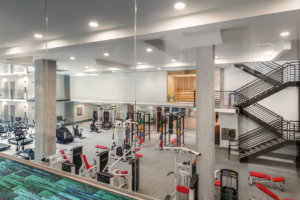For Optima® residents in and around Chicago, from Optima Signature® to Optima Lakeview® to Optima Verdana®, exploring the comedy world through The Second City’s performances — whether at its original theater in Old Town or via its digital media offerings — is a delightful way to connect with the city’s rich cultural history. The Second City serves as both a mirror and a guide, reflecting societal changes while shaping the future of comedy, making it an institution that truly represents the spirit of innovation, humor, and community.
Founded in 1959, The Second City was the brainchild of Paul Sills, along with Howard Alk and Bernie Sahlins. Sills, whose mother, Viola Spolin, was a pivotal figure in the development of improvisational theater techniques, was deeply inspired by her work. Spolin’s teachings on improvisation served as the foundation for much of what The Second City became known for: spontaneity, collaboration, and a focus on ensemble work rather than solo performances.

The theater began as a small cabaret-style venue in Chicago’s Old Town neighborhood. From its early days, The Second City differentiated itself from traditional comedy by embracing improvisation and the exploration of societal issues through satire. The performances were collaborative efforts, where actors built on one another’s work, creating scenes and sketches that were as insightful as they were funny. This unique approach to comedy set The Second City apart from other theaters and comedy clubs of its time.
A Launchpad for Talent
The Second City quickly gained a reputation as a workshop for budding comedic talent. The theater’s emphasis on improvisation helped to hone the skills of its performers, many of whom would go on to become household names. In fact, the list of The Second City alumni reads like a who’s who of American comedy, including John Belushi, Bill Murray, Gilda Radner, Tina Fey, Steve Carell, and Amy Poehler.
One of The Second City’s most significant contributions to comedy was its role in the creation of Saturday Night Live (SNL). The show’s original cast included several Second City alumni, and the theater has continued to provide talent for the long-running show. Over the years, SNL has tapped into The Second City’s pool of improvisers, bringing their distinct comedic sensibilities to a national audience.
Evolution of the Comedy Landscape
While improvisation remains at the heart of The Second City’s performances, the theater has also expanded its scope over the years. In addition to its original Chicago location, The Second City now has theaters in Toronto and Hollywood, and it operates training centers in multiple cities. The training centers are essential to The Second City’s mission, offering classes in improvisation, acting, and writing. These programs allow students of all ages and backgrounds to learn the craft of comedy and develop their own unique voices.
In addition to live performances, The Second City has also embraced digital media and television. Its Touring Company performs around the world, and The Second City’s sketches have been adapted into numerous television specials and series, helping to spread its brand of humor to an even wider audience.
Social Commentary and Satire
Throughout its history, The Second City has been deeply rooted in social commentary and satire. Many of the theater’s sketches tackle political, social, and cultural issues with wit and insight, offering audiences a way to laugh while also reflecting on the world around them. During the turbulent 1960s and 70s, The Second City’s satire helped define the theater’s identity, providing a comedic lens through which to view the often chaotic and confusing political landscape.
This tradition continues today, as The Second City performers address contemporary issues such as social justice, climate change, and technology. The theater’s ability to evolve with the times while maintaining its core principles of collaboration and improvisation is one of the reasons why The Second City remains as relevant today as it was when it first opened its doors.
For decades, The Second City has been a cultural institution that not only shaped the careers of countless comedians but also revolutionized the way comedy is performed and perceived. Its emphasis on improvisation and ensemble work, combined with its sharp social commentary, has made it a cherished and influential part of American culture. For Optima® residents, The Second City represents part of the rich tapestry of culture that offers up fresh new experiences that enhance our lives.
Visit The Second City website to learn more about its live and virtual programming!
























